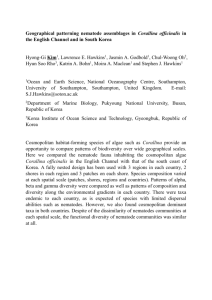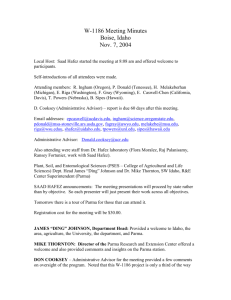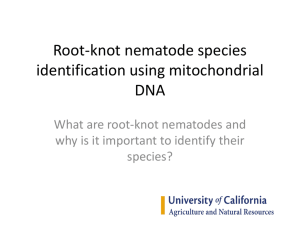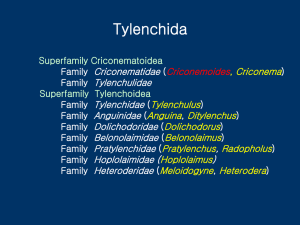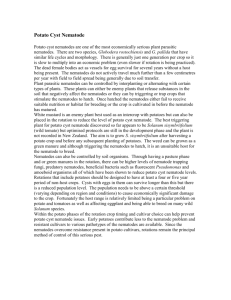page6226:31313 - UC Cooperative Extension
advertisement
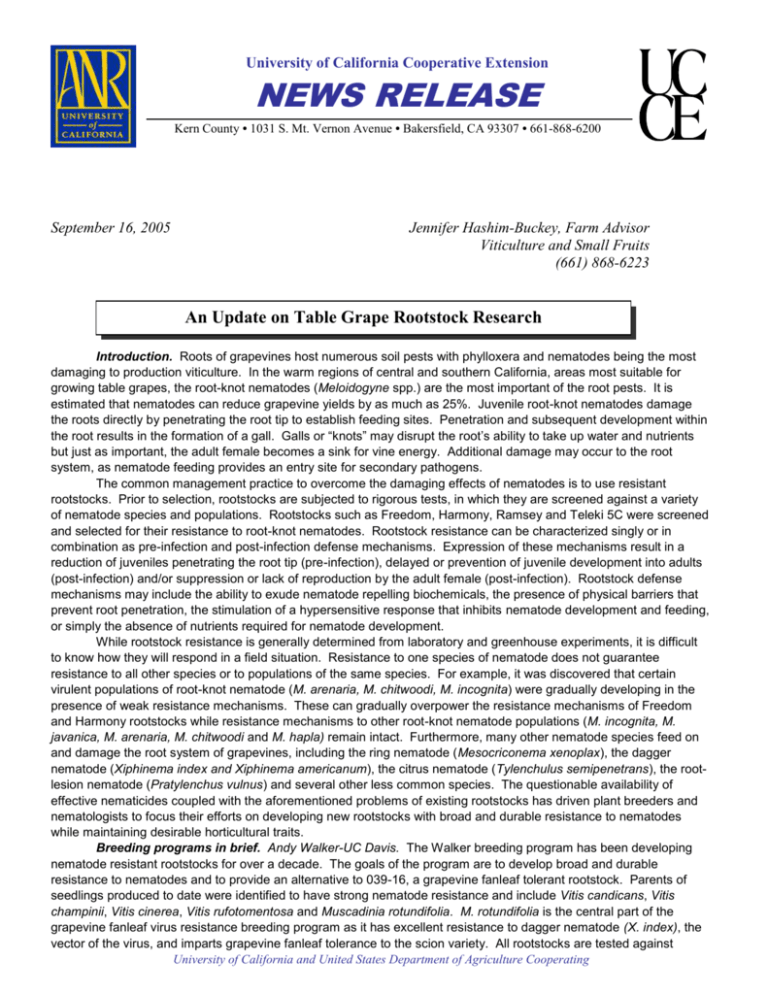
University of California Cooperative Extension NEWS RELEASE Kern County • 1031 S. Mt. Vernon Avenue • Bakersfield, CA 93307 • 661-868-6200 September 16, 2005 Jennifer Hashim-Buckey, Farm Advisor Viticulture and Small Fruits (661) 868-6223 An Update on Table Grape Rootstock Research Introduction. Roots of grapevines host numerous soil pests with phylloxera and nematodes being the most damaging to production viticulture. In the warm regions of central and southern California, areas most suitable for growing table grapes, the root-knot nematodes (Meloidogyne spp.) are the most important of the root pests. It is estimated that nematodes can reduce grapevine yields by as much as 25%. Juvenile root-knot nematodes damage the roots directly by penetrating the root tip to establish feeding sites. Penetration and subsequent development within the root results in the formation of a gall. Galls or “knots” may disrupt the root’s ability to take up water and nutrients but just as important, the adult female becomes a sink for vine energy. Additional damage may occur to the root system, as nematode feeding provides an entry site for secondary pathogens. The common management practice to overcome the damaging effects of nematodes is to use resistant rootstocks. Prior to selection, rootstocks are subjected to rigorous tests, in which they are screened against a variety of nematode species and populations. Rootstocks such as Freedom, Harmony, Ramsey and Teleki 5C were screened and selected for their resistance to root-knot nematodes. Rootstock resistance can be characterized singly or in combination as pre-infection and post-infection defense mechanisms. Expression of these mechanisms result in a reduction of juveniles penetrating the root tip (pre-infection), delayed or prevention of juvenile development into adults (post-infection) and/or suppression or lack of reproduction by the adult female (post-infection). Rootstock defense mechanisms may include the ability to exude nematode repelling biochemicals, the presence of physical barriers that prevent root penetration, the stimulation of a hypersensitive response that inhibits nematode development and feeding, or simply the absence of nutrients required for nematode development. While rootstock resistance is generally determined from laboratory and greenhouse experiments, it is difficult to know how they will respond in a field situation. Resistance to one species of nematode does not guarantee resistance to all other species or to populations of the same species. For example, it was discovered that certain virulent populations of root-knot nematode (M. arenaria, M. chitwoodi, M. incognita) were gradually developing in the presence of weak resistance mechanisms. These can gradually overpower the resistance mechanisms of Freedom and Harmony rootstocks while resistance mechanisms to other root-knot nematode populations (M. incognita, M. javanica, M. arenaria, M. chitwoodi and M. hapla) remain intact. Furthermore, many other nematode species feed on and damage the root system of grapevines, including the ring nematode (Mesocriconema xenoplax), the dagger nematode (Xiphinema index and Xiphinema americanum), the citrus nematode (Tylenchulus semipenetrans), the rootlesion nematode (Pratylenchus vulnus) and several other less common species. The questionable availability of effective nematicides coupled with the aforementioned problems of existing rootstocks has driven plant breeders and nematologists to focus their efforts on developing new rootstocks with broad and durable resistance to nematodes while maintaining desirable horticultural traits. Breeding programs in brief. Andy Walker-UC Davis. The Walker breeding program has been developing nematode resistant rootstocks for over a decade. The goals of the program are to develop broad and durable resistance to nematodes and to provide an alternative to 039-16, a grapevine fanleaf tolerant rootstock. Parents of seedlings produced to date were identified to have strong nematode resistance and include Vitis candicans, Vitis champinii, Vitis cinerea, Vitis rufotomentosa and Muscadinia rotundifolia. M. rotundifolia is the central part of the grapevine fanleaf virus resistance breeding program as it has excellent resistance to dagger nematode (X. index), the vector of the virus, and imparts grapevine fanleaf tolerance to the scion variety. All rootstocks are tested against University of California and United States Department of Agriculture Cooperating Schwarzmann RS-9 RS-3 RS-2 own root Freedom 6-19B University of California and United States Department of Agriculture Cooperating RS3 own root Freedom 1103-P RS2 Schwarzmann RS9 10-17A 1103-P 10-23B 10-17A Estimated no. of 19-lb. boxes per acre 10-23B 6-19B Pruning weight (lbs.vine) various species of root-knot nematode (including the more virulent biotypes described above) as well as citrus, lesion, pin and ring nematode individually and in combinations. Phylloxera resistance, fungal resistance, drought and salinity tolerance, and viticultural traits and also examined. Genetic mapping of resistance mechanisms is a key component to this program. Peter Cousins-USDA-ARS at Geneva, N.Y. The objective of the USDA Grape Rootstock Improvement Program is to breed, evaluate and introduce rootstocks that are resistant to root-knot nematode species, with specific emphasis on the resistance-breaking biotypes of M. arenaria. David Ramming USDA-ARS, Fresno, CA and Michael McKenry, UC Riverside. The emergence of resistancebreaking biotypes of M. arenaria and undesirable horticultural characteristics such as excessive vigor of existing rootstocks prompted an intensive screening of 520 selections from 1988 to 1992 at the USDA Plant Breeding Station in Fresno, CA. The rootstocks 10-17A, 6-19B, 10-23B, RS-2, RSFigure 1. Influence of rootstock on pruning 3 and RS-9 are products of the screening. The RS series weights for a 2-year old Princess vineyard. Arvin, CA. 2004. rootstocks are hybridized Ramsey (V. candicans x V. 25 rupestris) and Schwarzmann (V. riparia x V. rupestris) rootstocks. RS-3 and RS-9 rootstocks were released in 20 2004 to Foundation Plant Services in Davis, CA and are already available in limited supply. The RS-3 rootstock is 15 a moderately vigorous stock and is resistant to all common root-knot species plus the currently known 10 resistance-breaking biotypes of M. arenaria, M. 5 chitwoodi, and M. incognita. It reduces ring nematode populations by half and exhibits resistance to dagger (X. 0 index) and root lesion nematodes, plus has useful resistance to citrus nematode. In contrast, RS-9 is a lower vigor rootstock with similar nematode resistance characteristics as RS-3 except it offers no apparent protection against ring nematode. The 10-17A, 6-19B and 10-23B rootstocks also exhibit resistance to all common root-knot species and resistance-breaking biotypes and have varying degrees of resistance to other nematode species. Of the latter three, 10-17A offers the broadest nematode resistance. Results from rootstock trials conducted in Kern Figure 2. Influence of rootstock on the number of County and other areas in California indicate that 6-19B is far 19-lb. boxes per acre for a 2-year old Princess too weak (low vigor) to be a suitable table grape rootstock. vineyard. Arvin, CA. 2004. 1800.00 The rootstocks 10-23B and 10-17A were observed in a Cull 1600.00 Kern County trial to be of low to moderate vigor and to #2 & #3 Boxes 1400.00 #1 Boxes perform well in terms of yield and quality, particularly for 1200.00 extremely vigorous scion varieties such as Princess 1000.00 (Figure 1&2). However, it must be noted that the 800.00 devigorating effect (in the absence of soil pests) of these 600.00 two rootstocks on Princess grapevines may not be 400.00 observed with other scion varieties. Furthermore, this trial was established in 2002 and different trends may arise as 200.00 the vines mature. 0.00


